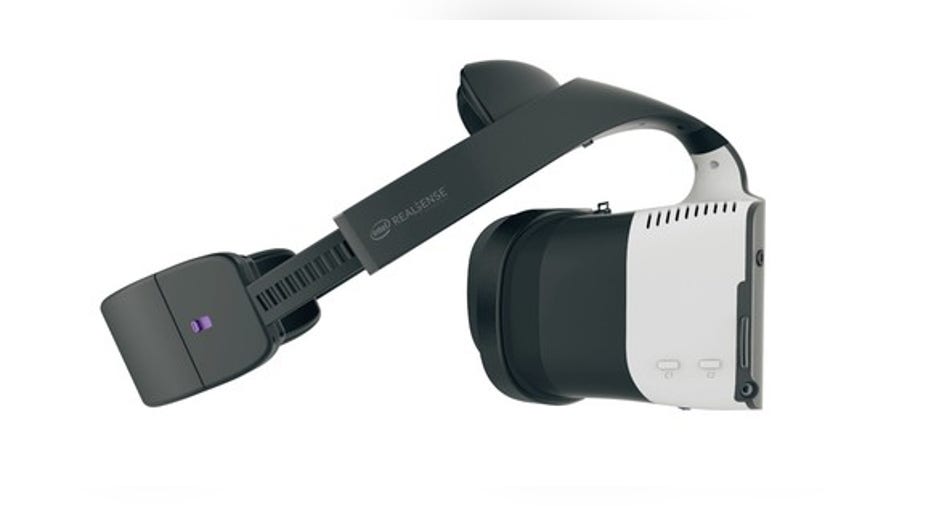Intel Corporation's Betting Big On VR

Determined not to make the same mistake as it did with its late arrival to the smartphone party, Intel (NASDAQ: INTC) recently announced a new, cutting-edge entrant to the fast-growing virtual reality (VR) market. While the VR device itself offers considerable opportunity, it's also important to investors and the Street that Intel got onboard in the early stages of a market with almost limitless upside.
As big as the VR market is forecast to become, most pundits agree that augmented reality (AR), or a "virtual" world in which users are still aware of their physical surroundings, is -- due to its commercial applications -- where the real opportunity lies. The good news for Intel fans and investors in search of a long-term growth and income alternativeis that it has that base covered as well.
Image source: Intel.
Introducing Project Alloy
CEO Brian Krzanich kicked off Intel's annual developer conference in San Francisco, CA last week with a bang. Krazanich introduced Project Alloy and its "merged reality," all-in-one headset. Though Intel describes project alloy as an "all-in-one virtual reality solution made from the ground up," it has applications for both VR and AR.
The headset stands apart from other VR and AR solutions in several ways. First, there are no VR-like "pesky cords" to deal with as the device is entirely self-contained. Similar to Microsoft's (NASDAQ: MSFT) HoloLens, alloy gives users the ability to safely roam an area with its built-in collision detection and avoidance sensors while retaining the merged reality experience.
Intel plans to open the ecosystem doors to developers and hopes to have its partners ready to deliver units next year. Intel added that it has come to a collaboration agreement with Microsoft in collision detection and avoidance sensors, to "optimize Windows-based content and experiences on Intel-based VR devices such as Alloy." And the arrangement between the two tech juggernauts doesn't stop there.
Phase two
Krzanich was joined by a Microsoft Windows exec onstage at the developer conference and announced that in addition to the opportunities that merged reality offers users of Microsoft's suite of business software, combined they were able to develop a PC gaming, merged reality experience that requires less powerful computers than VR headsets from the likes of Oculus Rift and Vive.
Both Rift and Vive require PC computing power that few consumers have, and costs for a unit with the power needed start around $1,000 and go up from there. Computing cost is a concern voiced by several pundits as a roadblock to overcome before VR reaches its full potential. With Microsoft's assistance, Intel's alloy could very well prove to be the solution VR gamers have been looking for.
Where to from here
While VR garners much of the press, the AR market is expected to dwarf virtual reality in the coming years. According to one forecast, of the $150 billion in combined revenue the two alternate realities are expected to generate by 2020, AR will garner a whopping $120 billion of that thanks to its multiple commercial uses.
Microsoft HoloLens already has commercial arrangements with leading auto manufacturers, software design developers including Autodesk, construction, and education providers, among a host of others. So what does that mean for Intel? Unlimited potential because alloy's merged reality experience essentially combines the two technologies so both VR gamers and construction engineers, as an example, can each use a variation of the same, alloy-developed device.
The result is Intel-powered alloy headsets will garner a piece of both the VR and AR $150 billion pie in the coming years. That said, in the near-term Intel will continue to rely on its cloud-based data center sales, security, and Internet of Things (IoT) to drive topline growth, and make up for its waning Client Computing Group, which declined again last quarter to $7.3 billion, down 3% year-over-year.
With its stock price bumping up against 52-week highs, investors are finally recognizing that Intel's future lies in the cloud, IoT, and related markets. But as the new alloy headset and agreement with Microsoft attest, it's not going to miss out on another up-and-coming opportunity, which should be music to the ears of Intel shareholders.
A secret billion-dollar stock opportunity The world's biggest tech company forgot to show you something, but a few Wall Street analysts and the Fool didn't miss a beat: There's a small company that's powering their brand-new gadgets and the coming revolution in technology. And we think its stock price has nearly unlimited room to run for early in-the-know investors! To be one of them, just click here.
Tim Brugger has no position in any stocks mentioned. The Motley Fool owns shares of Microsoft. The Motley Fool recommends Intel. Try any of our Foolish newsletter services free for 30 days. We Fools may not all hold the same opinions, but we all believe that considering a diverse range of insights makes us better investors. The Motley Fool has a disclosure policy.